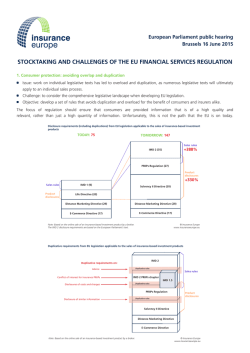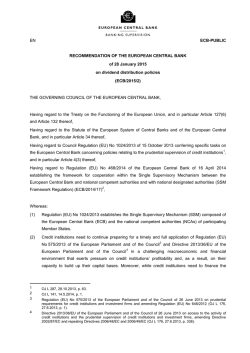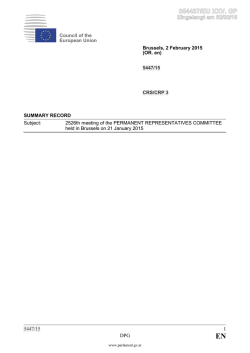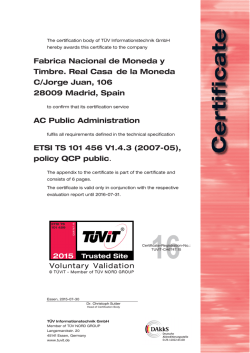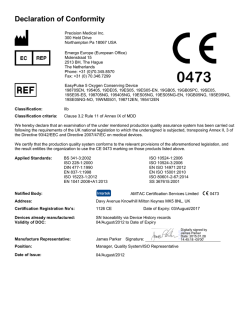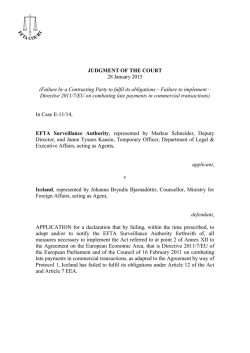
Inycom
Safety in electromagnetic fields EMF Directive 2013/35/EU Corporate responsibility, worker safety The long road to implementation The first Directive on the minimum health and safety requirements regarding the exposure of workers to the risks arising from electromagnetic fields was published as far back as 2004. Primarily, concerns from among medical circles led to the repeal of this initial version and its replacement by the new EMF Directive 2013/35/EU, which came into force in June 2013. EU member states must implement this Directive in their national laws by 1st July 2016. The EU member states are required to enact the necessary legislative and administrative regulations by 1 st July 2016. New Directive with practical values All the known direct biophysical effects and indirect effects of electromagnetic fields are included in the new Directive in order to guarantee the health and safety of workers. The specified limit values and personal protective measures have been determined on the basis of the latest scientific findings and refer exclusively to the scientifically proven direct short-term effects. And it’s good to know that the Directive is not intended to cancel any existing, more stringent national limit value regulations. Now is the time for companies to act To protect workers, all places of work must be subjected to a risk assessment according to the requirements of the EMF Directive. The physical quantities, exposure limit levels and action levels specified in the Directive are based on the recommendations of the International Commission for Non-Ionizing Radiation Protection (ICNIRP). Of help here is the reference to a range of indicators and standard situations, which have been made available in guidelines. The sanctions that can be applied to a company in the event of a violation vary from one EU state to another. Whatever the case, these must be effective, appropriate, and deterrent. The main points of EMF Directive 2013/35/EU of 26 June 2013 The Directive envisages the performance of a risk assessment for all places of work within the EU, with the result being documented, for example in the form of suitable measurements. The responsibility for doing this is borne by the employer, who must additionally take measures to prevent or reduce the risks. The Directive applies to exposure to electric, magnetic, and electromagnetic fields with frequencies from 0 Hz to 300 GHz. Biophysical effects A distinction is made between two types of direct biophysical effects that can be caused by electromagnetic fields: Employers’ obligations Employers must ensure that the exposure limit values are not exceeded. They can use Thermal effects such as tissue heating through energy absorption. These mainly occur in fields in the frequency range from 100 kHz to 300 GHz. emission data provided by equipment manufacturers Stimulation of muscles, nerves and sensory organs. These effects are mostly caused by fields in the frequency range from 0 Hz to 10 MHz. The Directive names other indirect effects such as spark discharges, contact currents, interference with medical electronic equipment (such as cardiac pacemakers or other implants), as well as the projectile risk from ferromagnetic objects in static magnetic fields. Exposure limit values and action values All exposure limit values (ELVs) refer to the field values within the human body. In this regard, the Directive defines ELVs for sensory effects: Limits for transient disturbed sensory perceptions ELVs for health effects: Limits for adverse thermal or non-thermal health effects As it is impossible to measure the field values within the human body and to otherwise determine such values would involve highly complex calculations, the Directive defines so-called action levels. Action levels (ALs) are field values at the place of work up to the level of which the exposure level values are deemed to have not been exceeded. These can be measured directly. A distinction is made between Low action levels (Low ALs) for sensory effects High action levels (High ALs) for health effects Protective or preventive measures must be taken as soon as the low ALs are exceeded. measurements, or calculation to assess the risks and determine the exposure levels. The assessment must be performed by a professional service or persons, repeated at appropriate intervals, and documented in a form that is traceable. In addition, the Directive obligates employers to undertake measures to avoid or reduce the risks, to inform employees and / or their representatives of such risks and explain the possible consequences or effects. The risk of injury can also be reduced by means of personal protective equipment (e.g. warning devices). This is particularly prudent where increased exposure levels can occur in variable areas of work. Exceptions Special regulations apply to research and development, and the use of magnetic resonance imaging (MRI) in the medical field. Differing protection systems can be used in operational military equipment or during military action. Here, too, care must be taken to ensure that effects detrimental to health and any safety risks are avoided. Measured verification of action levels according to Directive 2013/35/EU Non-thermal effects from 0 Hz to 10 MHz Thermal effects from from 100 kHz to 300 GHz Wideband measuring devices ELT-400 THM1176 NBM-520 NBM-550 Selective measuring devices EHP-50F EHP-200A SRM-3006 Personal protection devices Nardalert S3 RadMan Limit values for non-thermal effects: Exposure limit values and action levels in the frequency range from 0 Hz to 10 MHz Action levels for electric fields (E) Electric field E Magnetic field B Action levels for magnetic fields (B) Frequency Frequency Limit values for thermal effects: Exposure limit values and action levels in the frequency range from 100 kHz to 300 GHz Action levels for magnetic fields (B) 6-minute average values (RMS) Electric field E Magnetic field B Action levels for electric fields (E) 6-minute average values (RMS) Frequency Frequency Measurement solutions from Narda: Protection across the entire bandwidth Narda is one of the leading providers of high quality, tailor made measurement solutions. The comprehensive product range for human safety in electromagnetic fields (EMF) comprises wideband measuring devices, selective measuring instruments, monitoring systems, and personal monitors. Original measurement accuracy means security When something happens, being able to prove the accuracy of measurements can be vital. So it is best to be on the safe side with a regularly calibrated measuring device. That is why Narda, as an accredited calibration lab for field strength measuring devices, offers an additional bonus for even more reliability and security with three of the most modern calibration labs worldwide. Narda measuring devices for electric and magnetic fields, wideband or selective, from 0 Hz to 60 GHz. Personal safety devices RadMan, Nardalert Non-thermal effects THM, EHP, ELT Thermal effects NBM, SRM roener-design.de Narda Safety Test Solutions GmbH Sandwiesenstraße 7 72793 Pfullingen, Germany Tel. +49 7121 97 32 0 Fax +49 7121 97 32 790 [email protected] www.narda-sts.com Narda Safety Test Solutions 435 Moreland Road Hauppauge, NY11788, USA Phone +1 631 231-1700 Fax +1 631 231-1711 [email protected] www.narda-sts.us Narda Safety Test Solutions srl Via Leonardo da Vinci, 21/23 20090 Segrate (MI) ITALY Phone +39 02 26 998 71 Fax +39 02 26 998 700 [email protected] www.narda-sts.it NSTS 07/15-ME-D314A Technical advances, errors and omissions excluded. © Narda Safety Test Solutions 2014. ® The name and logo are registered trademarks of Narda Safety Test Solutions GmbH and L3 Communications Holdings, Inc. – Trade names are the trademarks of their respective owners. Conforms to EMF Directive
© Copyright 2026
